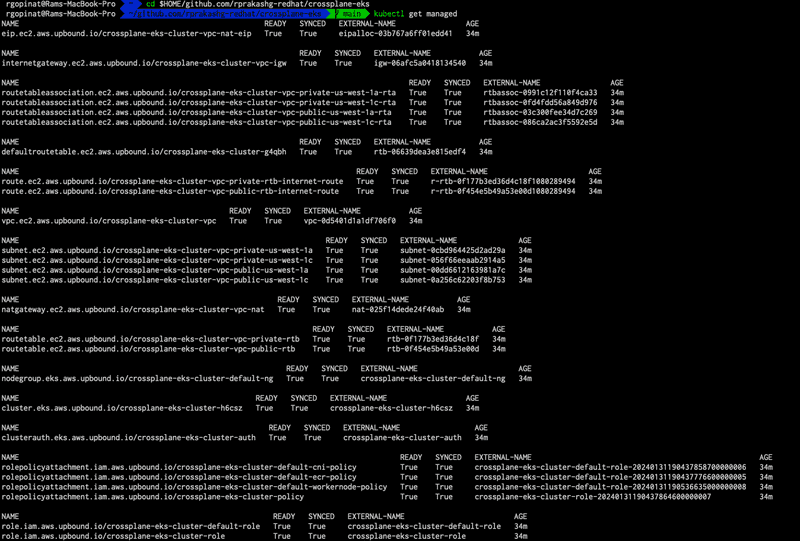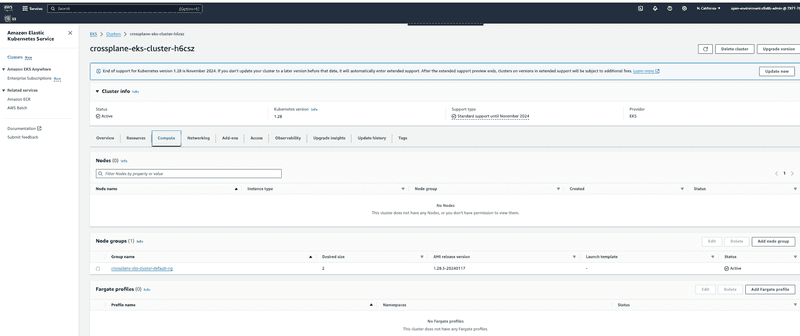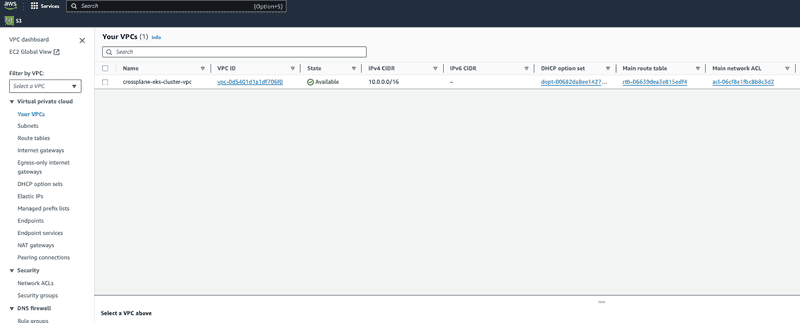Automating provisioning of EKS Clusters with Crossplane
Published on January 30, 2024 by Ram GopinathanI've been hearing a lot about Crossplane for over a year now and recently I got a chance to try it out, specifically resource composition capabilities. In this post I'll go over how I used these capabilities to build a system that automates provisioning of EKS clusters in AWS. I hope you are just as excited as I am. What I liked the most is that crossplane allows us to extend kubernetes without really writing single line of go code or having to be expert in kubernetes operators. Everything I'm going to cover here is in this github repo. Lets jump right into it.
Provision an EKS cluster by running terraform scripts included in the infra directory in the github repo, this cluster is going to act as a tools cluster where I will be installing crossplane.
Create the tools cluster by running terraform commands below
cd infra
terraform init
terraform plan
terraform applyAfter terraform commands are completed successfully we can see that the cluster was provisioned and is active from the screen capture below.
Install crossplane using helm chart. This is pretty well documented here
helm repo update
helm install crossplane \
crossplane-stable/crossplane \
--namespace crossplane-system \
--create-namespaceLets verify that the crossplane pods are running and healthy
kubectl get pods -n crossplane-systemand we can see that all crossplane system pods are up and running
Install following crossplane AWS providers shown below. Providers enable crossplane to provision infrastructure on an external service. For more info on other providers including the AWS ones listed below checkout https://marketplace.upbound.io/providers
Install a go templating composition function which I'll use when defining resource composition for the composite API we will define later in this post. For more information about this function check out the upbound marketplace https://marketplace.upbound.io/functions/crossplane-contrib/function-go-templating/v0.4.1
cat <<EOF | kubectl apply -f -
apiVersion: pkg.crossplane.io/v1beta1
kind: Function
metadata:
name: function-go-templating
spec:
package: xpkg.upbound.io/upbound/function-go-templating:v0.4.1
EOFverify that the function was installed successfully and running healthy.
kubectl get functionSetup cloud provider credentials. Run command below to create a credentials file. Be sure to create an IAM account with required privileges and set the environment variables referenced in the below command with respective values that match your environment.
echo "[default] \naws_access_key_id = ${AWS_ACCESS_KEY_ID}\naws_secret_access_key = ${AWS_SECRET_ACCESS_KEY}" > aws-credentials.txtBe sure to not checkin the aws-credentials.txt file to github by including an entry in your .gitignore file to ignore it
Create a kubernetes secret from aws-credentials.txt file by running command below
kubectl create secret \
generic aws-secret \
-n crossplane-system \
--from-file=creds=./aws-credentials.txtCreate a provider config resource to customize the settings of the AWS provider. Basically this is how we tell the crossplane AWS provider how to authenticate with AWS.
cat <<EOF | kubectl apply -f -
apiVersion: aws.upbound.io/v1beta1
kind: ProviderConfig
metadata:
name: aws-config
spec:
credentials:
source: Secret
secretRef:
namespace: crossplane-system
name: aws-secret
key: creds
EOFCreate Composite Resource Definitions
Composite resource definitions (XRDs) allows us to define the schema for custom APIs. All schemas follow kubernetes custom resource definition OpenAPIv3 structural schema. Since I want the cluster to be provisioned within its own VPC with public and private subnets and route tables I decided to create 2 custom APIs. 1) Virtualnetwork (Creates VPC with subnets and route tables, Internet Gateway, NAT Gateway, Routing rules). 2) EKSCluster (Creates EKS Clusters with managed nodegroups and virtual network). Both APIs can be found here
Create the XRDs by running the command below.
kubectl apply -f apis/virtualnetwork.yaml
kubectl apply -f apis/ekscluster.yamlWe can verify that the XRD's are created by running kubectl get xrd
Create Compositions
Compositions are like a deployment template for provisioning a group of resources as single object. I've defined the composition logic for both virtualnetwork and ekscluster XRDs and will go ahead and create them. In summary all required steps for provisioning VPC with subnets and route tables are defined in the composition for virtualnetwork and all resources that need to be created to have a fully functional eks cluster are defined in the composition for ekscluster XRD. You can see in the composition file I'm basically defining all the managed resources defined in the providers and crossplane takes care of provisioning them in my AWS account. You'll also notice each managed resource has a providerConfigRef property that we are using to tell crossplane system how to authenticate with the AWS account which we configured earlier.
You can also see in the composition for ekscluster XRD that I'm nesting the VirtualNetwork XRD instead of duplicating all the logic of provisioning VPC, Subnets, route tables etc. By moving that into a seperate XRD allows us to reuse it for other usecases as well
kubectl apply -f composition/virtualnetwork.yaml
kubectl apply -f composition/ekscluster.yamlWe can see that composition resources are created successfully for our XRDs
Creating an EKS cluster
We can now create an EKS cluster by simply running command below
cat <<EOF | kubectl apply -f -
apiVersion: stacks.aws.io/v1alpha1
kind: EKSCluster
metadata:
name: crossplane-eks-cluster
spec:
region: "us-west-1"
version: "1.27"
compute:
nodeGroups:
- name: default
instanceType: t3.medium
scaling:
minSize: 2
maxSize: 3
desiredSize: 2
availabilityZones:
- us-west-1a
- us-west-1c
networking:
name: crossplane-eks-cluster-vpc
cidr: 10.0.0.0/16
publicSubnet:
cidr:
- 10.0.3.0/24
- 10.0.4.0/24
privateSubnet:
cidr:
- 10.0.1.0/24
- 10.0.2.0/24
EOFTo see a list of managed resources that are created and their status we can run kubectl get managed
When READY and SYNCED for all managed resources show value 'True' this means that everything was provisioned successfully in AWS. If you see it stuck in False we can run kubectl describe {replace with managed resource} to see more details about why its stuck.
Additionally you can login to AWS console and verify all resources are successfully provisioned. Screen capture below shows EKS cluster provisioned with default managed node group
Browse to VPC in console and verify all resource provisioned. Screen capture below shows VPC that was created by crossplane
So far I'm really liking what I've been able to do with Crossplane, I plan to extend this to be able to define cluster recipes (Small/Medium, Large as an example) so folks requesting cluster don't even have to know anything about networking, compute etc. Also I could have defined XRDs more provider agnostic and not use EKS, Availability Zone etc in the api spec.
Hope this post helped spawn new ideas if you are a platform builder or building tools for enterprise.
As always feel free to reach out if you have any questions about this post
Thanks, Ram









